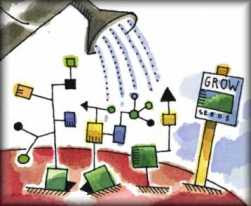The above [development, definitions] can be explained more coherently by reflecting on events and influences at the time when Brian Hodges first created the model commuting between Manchester and his home in Sheffield in the NW England. We can compare and contrast the situation from 1983-84 and so highlight:
• models of nursing
• the nursing process
• individualised care (through the nursing process)
• mind mapping
 Models of nursing and nursing theory are still there on nursing curricula. Students still write the essays in their first year (as I learned this week), but their importance on many nursing courses - be that foundation, the adult, paediatric, learning disability or mental health branches; or post-graduate is diminished. This does not mean to the extent that they are no longer worthy of Masters dissertations and Doctorates, but the academic agenda and theoretical emphasi*, found in the curricula, practice and management have however moved on. The nursing process is now transparent, it is embedded into theory and practice in the form of paper (the nursing Kardex) and electronic record formats. What is interesting is that individualised, or personalised care remains a challenge to achieve and measure. The final item listed above - mind mapping - is in many respects coincidental, but was concurrent and of great importance for Hodges' model, informatics and the social sciences. For decades before Hodges' model was created the potential of diagrammatic forms and representation as an educational and learning tool was recognised and championed in several quarters notably in the 1970s by Buzan and others.
Models of nursing and nursing theory are still there on nursing curricula. Students still write the essays in their first year (as I learned this week), but their importance on many nursing courses - be that foundation, the adult, paediatric, learning disability or mental health branches; or post-graduate is diminished. This does not mean to the extent that they are no longer worthy of Masters dissertations and Doctorates, but the academic agenda and theoretical emphasi*, found in the curricula, practice and management have however moved on. The nursing process is now transparent, it is embedded into theory and practice in the form of paper (the nursing Kardex) and electronic record formats. What is interesting is that individualised, or personalised care remains a challenge to achieve and measure. The final item listed above - mind mapping - is in many respects coincidental, but was concurrent and of great importance for Hodges' model, informatics and the social sciences. For decades before Hodges' model was created the potential of diagrammatic forms and representation as an educational and learning tool was recognised and championed in several quarters notably in the 1970s by Buzan and others.So, in 2010 we can identify needs - both old and new - to account for #:
- person-centred care
- public engagement
- preventive health programs (NHS = 'ill NHS')
- public health and public mental health (in which mental health is still 'lost')
- global health and nursing's role in achieving the aspirations of health for all (bridging other divides - local - global: glocal)
- information technology - various schools of informatics
- self-care
- demographic trends
- economics and care delivery / commissioning models
- information and visual literacy
* emphasi = neologism: it just sounds right?
# At the same time - is that possible?
(Notes V to follow)
[These are notes. If you have any thoughts, views on a new introduction to the model please get in touch:
h2cmng @ yahoo.co.uk What do you feel needs to be explained? Which audience should be addressed in the first instance? What assumptions can be made? ....? Many thanks PJ ]
Notes I intro for 2010
Notes II intro for 2010
Notes III intro for 2010
